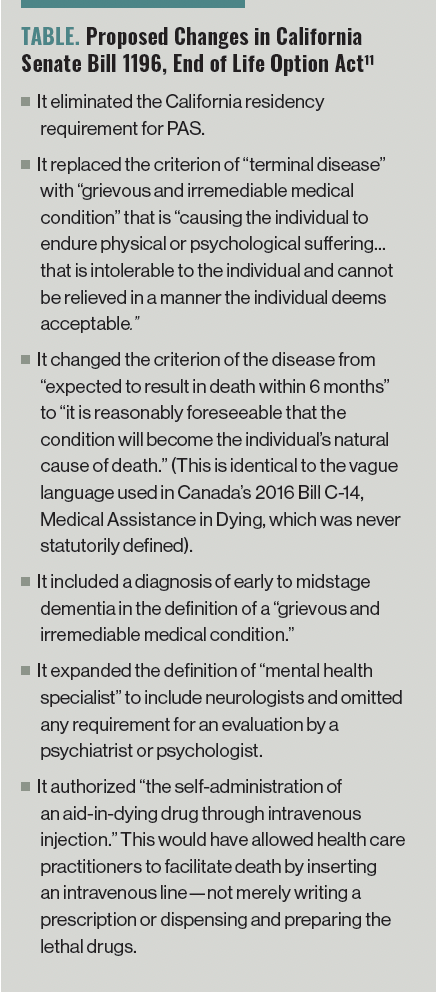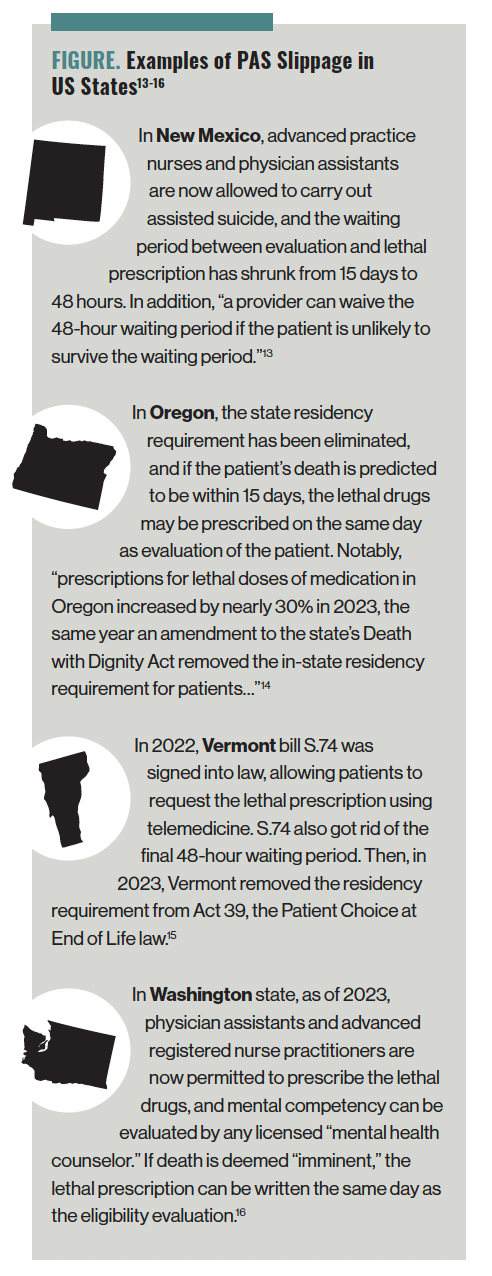Publication
Article
Psychiatric Times
Beyond Terminal Illness: The Widening Scope of Physician-Assisted Suicide in the US
Author(s):
Physician-assisted suicide is now legal in 11 jurisdictions in the US. To this, several clinicians say: “We must care for the dying, not make them dead.” Learn more in our June cover story.

COMMENTARY
Physician-assisted suicide (PAS)—commonly but misleadingly called “medical aid in dying”1—is now legal in 11 jurisdictions in the US. PAS remains an area of great controversy among physicians, medical ethicists, and various patient advocacy groups, as evidenced by numerous opinion pieces in Psychiatric Times.2,3 While we recognize that individuals of good conscience may differ on the ethics of PAS, we have consistently maintained—as the American Medical Association has opined—that4:
“Physician-assisted suicide is fundamentally incompatible with the physician’s role as healer, would be difficult or impossible to control, and would pose serious societal risks.”
This position has also been consistently taken by the World Medical Association.5 Despite such clear statements, we and others have called attention to the ever-expanding eligibility criteria for PAS/euthanasia (PAS/E), particularly in Canada, Belgium, and the Netherlands. In essence, every one of these foreign jurisdictions that has legalized PAS/E has eventually expanded them—a phenomenon often referred to as “the slippery slope.”6
The expansion typically begins with the “low-hanging fruit” of end-stage or terminal illness and gradually broadens to “chronic, nonterminal, or treatment-refractory illness,” as one of us (M.S.K.) has shown.7
Whenever a line is drawn to limit eligibility criteria, those just outside the line protest, based on understandable (if misplaced) ethical principles of justice, fairness, and parity. Consequently, the boundaries of eligibility for PAS/E have been greatly stretched—in practice, in law, and in guidelines issued by professional organizations.8
As opponents of PAS/E, we often hear proponents claim that the slippery slope argument is merely hypothetical—an alarmist bogeyman used to scare away supporters of PAS/E.9 We also hear that, even if the slippery slope metaphor applies in foreign countries, “it would never happen here” in the US. We respectfully disagree. Although the angle of the slope is considerably greater in Canada and the Benelux countries (Belgium, the Netherlands, and Luxembourg) than in the US, we find troubling signs of slippage here at home.
In this piece, we critically examine 2 such examples: (1) the introduction of California Senate Bill 1196, along with expanded PAS criteria in several other states; and (2) 3 cases of PAS in Colorado, in which patients with anorexia nervosa died from lethal prescribed drugs.
SB 1196: A Harbinger of Things to Come?
Table. Proposed Changes in California Senate Bill 1196, End of Life Option Act11

California Senate Bill 1196, the End of Life Option Act, was introduced by Senator Catherine Blakespear and represented a radical departure from existing California law.10 SB 1196 proposed several changes (Table).11 Additionally, it contained language that would have turned these practices into a quasi-research protocol by requiring the prescribing physician to report the type of lethal medications prescribed, the time from drug ingestion/administration to death, and any observed complications.
This radical bill was “a bridge too far” even for some groups that have long supported PAS. For example, the group Compassion & Choices stated, “Compassion & Choices and the Compassion & Choices Action Network respectfully oppose SB1196…” which the group viewed as posing “…significant risks to the current medical aid-in-dying law, potentially undermining its purpose and availability.”12
Ultimately—and fortunately—Blakespear withdrew this extreme proposal, and California dodged the proverbial bullet. However, in our view, the mere fact that SB 1196 was proposed is cause for great concern and a sign of the slippage we have witnessed in other countries.
Stretching the Boundaries: Slippage in Several States
Figure. Examples of Euthanasia Slippage in US States13-16

This extraordinary attempt to expand California’s law illustrates what many states may expect if laws permitting PAS (or euthanasia) are adopted. Indeed, contrary to the it-can’t-happen-here argument, we have already seen examples of slippage in several US states (Figure).13-16 These expansionary rules may be categorized as modifications of (1) waiting periods for PAS; (2) conditions of PAS eligibility; or (3) expansion of authority to carry out PAS. Or they may be some combination of these modifications. As expansive as these recent modifications are, they pale in comparison to the radical changes proposed in
SB 1196.
The Colorado Anorexia Nervosa Cases
In March of 2022, the Colorado Sun ran the following headline: “Denver doctor helped patients with severe anorexia obtain aid-in-dying medication, spurring national ethics debate.”17
The backstory, as told in the Colorado Sun article, was this17:
“Dr Jennifer Gaudiani, an internal medicine doctor who specializes in eating disorders, published a paper in which she describes the deaths of [3] patients with anorexia nervosa [AN]. One 36-year-old woman died after ingesting the lethal doses prescribed by another doctor, with Gaudiani serving as consulting physician. Another 36-year-old woman died of severe malnutrition on the same day she planned to take aid-in-dying medication prescribed by Gaudiani.”
The third patient—Alyssa B—was actually a coauthor of the paper with Gaudiani. According to the published paper, “Dr G prescribed the [medical aid in dying] medications about 6 weeks after Alyssa entered hospice care.”18
The Gaudiani et al paper is notable in acknowledging that:
“Alyssa had not completed a full residential eating disorder program; never fully restored weight; never tried newer psychedelic options such as ketamine, psilocybin, or MDMA; and hadn’t had a feeding tube. Dr G acknowledged that all but the feeding tube might ordinarily be undertaken prior to someone’s seeking end-of-life care for AN. Yet, [Alyssa] had been suffering for so long, and despite many conversations about all these treatment possibilities, Alyssa would not consent to any of them. Therefore, given her clarity of understanding around these issues and her sense that she could not fight anymore, everyone had to accept that they weren’t meaningful options.”
Not surprisingly, the published paper and its rationale were vociferously criticized by many in the psychiatric community. For example, Angela Guarda, MD—the director of the eating disorders program at Johns Hopkins Hospital in Baltimore, Maryland—is quoted as saying that using aid-in-dying medication for anorexia patients is “alarming” and “fraught with problems.” This is partly because “…it is impossible to disentangle this request [for PAS] from the effects of the disorder on reasoning, and especially so in the chronically ill, demoralized patient who is likely to feel a failure.”17
We strongly agree with Guarda and regard the 3 cases as exemplifying the slippery slope of eligibility for PAS/E in the US. One of us [C.M.A.G.] has argued that the concept of futility in the treatment of anorexia nervosa is not supported by current evidence and should not serve as the basis for decision-making in this condition.19,20
Concluding Thoughts
In our view, the phenomenon of the slippery slope is, in large part, the expectable consequence of “normalizing” or naturalizing the physician’s direct or indirect killing of the patient via euthanasia or PAS, respectively. The more widely these acts are performed, the easier it becomes to mischaracterize them as forms of “medical care.” This is epitomized in the obfuscating euphemism medical aid in dying. As the American College of Physicians has stated21:
“Terms for physician-assisted suicide, such as aid in dying, medical aid in dying, physician-assisted death, and hastened death, lump categories of action together, obscuring the ethics of what is at stake and making meaningful debate difficult.”
In truth, assisted suicide does not aid the dying process—it terminates dying by terminating the patient.
By the same token, the more PAS/E are viewed as medical care, the easier it becomes to broaden the eligibility criteria to encompass almost anyone who feels they are “suffering.” Then the slide down the slope can accelerate, from terminal conditions to chronic conditions (such as mental illness), as is happening in our culturally and geographically adjacent neighbor, Canada. That opens the path for the next drift in the evolving ethos—transforming one’s opportunity to seek these lethal procedures into the virtue of relieving loved ones from the burden of their condition.
Finally, we believe it essential that the American Psychiatric Association (APA) maintain its ethical opposition to PAS/E, consistent with the American Medical Association (AMA) Code of Ethics.4 Doing otherwise will create a schism between the APA and the AMA. Indeed, we hope that as our colleagues consider these issues, they bear in mind the teaching from medical ethicist Leon Kass, MD: “We must care for the dying, not make them dead.”22
Dr Komrad is a psychiatrist on the teaching staff of Johns Hopkins Hospital in Baltimore, Maryland. He is also a clinical assistant professor of psychiatry at the University of Maryland in Baltimore and on the teaching faculty of psychiatry at Tulane University in New Orleans, Louisiana. Dr Hanson is director of the forensic psychiatry fellowship at the University of Maryland in Baltimore. Dr Geppert is a professor in the Departments of Psychiatry and Internal Medicine and director of ethics education at the University of New Mexico School of Medicine in Albuquerque. She is the lead ethicist for the Western region and director of education at the Veterans Health Administration National Center for Ethics in Health Care in Washington, DC, and an adjunct professor of bioethics at the Alden March Bioethics Institute of Albany Medical College in New York. She serves as the ethics editor for Psychiatric Times. Dr Pies is a professor emeritus of psychiatry and a lecturer on bioethics and humanities at SUNY Upstate Medical University in Syracuse, New York; a clinical professor of psychiatry emeritus at Tufts University School of Medicine in Boston, Massachusetts; and editor in chief emeritus of Psychiatric Times (2007-2010). Dr Pies is the author of several books. A collection of his works can be found on Amazon.
For Further Reading
- National Association of Anorexia Nervosa & Associated Disorders (ANAD). ANAD Statement on 'Terminal Anorexia' (updated). https://anad.org/terminal-anorexia-statement/
References
1. Coelho R, Lemmens T, Gaind KS, Maher J. Normalizing death as “treatment” in Canada: whose suicides do we prevent, and whose do we abet? World Med J. 2022;70(3):27-35.
2. Kuntz L. Physician-assisted suicide: a pressing question of ethics and humanity. Psychiatric Times. January 29, 2022. https://www.psychiatrictimes.com/view/physician-assisted-suicide-a-pressing-question-of-ethics-and-humanity
3. Heinrichs DW. Medical aid in dying: burdened by suffering and loss of dignity. Psychiatric Times. January 6, 2023. https://www.psychiatrictimes.com/view/medical-aid-in-dying-burdened-by-suffering-and-loss-of-dignity
4. Council on Ethical and Judicial Affairs. Opinion 5.7: physician-assisted suicide. In: Code of Medical Ethics. American Medical Association; 2016. Accessed May 17, 2024. https://code-medical-ethics.ama-assn.org/ethics-opinions/physician-assisted-suicide
5. WMA declaration on euthanasia and physician-assisted suicide. World Medical Association. October 2019. Accessed May 2, 2024. https://www.wma.net/policies-post/declaration-on-euthanasia-and-physician-assisted-suicide/
6. Komrad MS. Medical aid in dying: a slippery slope. Psychiatric Times. August 27, 2021. https://www.psychiatrictimes.com/view/medical-aid-in-dying-slippery-slope
7. Komrad MS. Euthanasia and assisted suicide for psychiatric patients: lessons from Europe, Canada and the US. Mark Komrad YouTube page. December 2, 2023. Accessed May 2, 2024. https://www.youtube.com/watch?v=BnMi6J_SmJ8
8. Pullman D. Slowing the slide down the slippery slope of medical assistance in dying: mutual learnings for Canada and the US. Am J Bioeth. 2023;23(11):64-72.
9. Potter J. The psychological slippery slope from physician-assisted death to active euthanasia: a paragon of fallacious reasoning. Med Health Care Philos. 2019;22(2):239-244.
10. Bluth R. Lawmaker withdraws sweeping California bill to expand assisted dying. Politico. April 17, 2024. Accessed May 2, 2024. https://www.politico.com/news/2024/04/17/lawmaker-withdraws-california-bill-assisted-dying-00152840
11. End of Life Option Act. S 1196. 2023-2024 Session (Ca 2024). Accessed April 23. https://legiscan.com/CA/text/SB1196/id/2963562
12. Statement in response to SB 1196, legislation to expand California’s End of Life Option Act (SB380). Compassion & Choices. News release. March 20, 2024. Updated March 29, 2024. Accessed May 2, 2024. https://web.archive.org/web/20240416092810/https://www.compassionandchoices.org/news/statement-in-response-to-sb-1196
13. New Mexico: Introduction to Medical Aid in Dying. Compassion & Choices NM. Accessed May 2, 2024. https://www.compassionandchoices.org/docs/default-source/new-mexico/nm-medical-aid-in-dying-final-6-23-21.pdf
14. Wyatt S. Prescriptions for lethal doses of medication in Oregon increased by nearly 30% in 2023. Statesman Journal. March 21, 2024. Accessed May 2, 2024. https://www.statesmanjournal.com/story/news/health/2024/03/21/oregon-lethal-medication-prescriptions-increased-nearly-30-in-2023/73047612007/
15. Patient Choices Vermont. Guidelines and checklist for non-residents of Vermont and their doctors. Accessed May 2, 2024. https://www.patientchoices.org/non-residents.html
16. The Protecting Access to Medical Aid-in-Dying Act. End of Life Washington. Accessed May 2, 2024. https://endoflifewa.org/the-law/
17. Brown J. Denver doctor helped patients with severe anorexia obtain aid-in-dying medication, spurring national ethics debate. Colorado Sun. March 14, 2024. Accessed May 2, 2024. https://coloradosun.com/2022/03/14/denver-doctor-gaudiani-aid-in-dying-aneroexia-patients/
18. Gaudiani JL, Bogetz A, Yager J. Terminal anorexia nervosa: three cases and proposed clinical characteristics. J Eat Disord. 2022;10(1):23.
19. Geppert CM. Futility in chronic anorexia nervosa: a concept whose time has not yet come. Am J Bioeth. 2015;15(7):34-43.
20. Westmoreland P, Geppert CMA, Komrad MS, et al. “Terminal anorexia”: an invalid construct that does not justify medical aid in dying. Psychiatric Times. October 11, 2023. https://www.psychiatrictimes.com/view/terminal-anorexia-an-invalid-construct-that-does-not-justify-medical-aid-in-dying
21. Sulmasy LS, Mueller PS. Ethics and the legalization of physician-assisted suicide. Ann Intern Med. 2018;168(11):834-835.
22. Kass LR. Dehumanization triumphant. First Things. August 1996. Accessed May 2, 2024. https://www.firstthings.com/article/1996/08/dehumanization-triumphant






